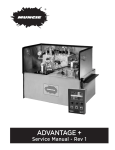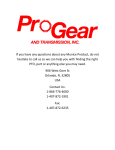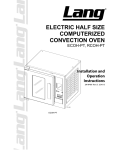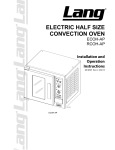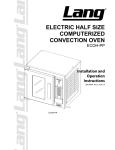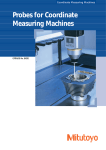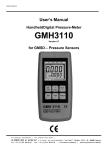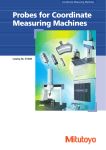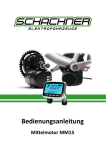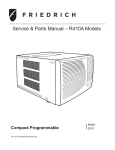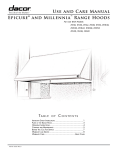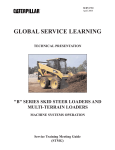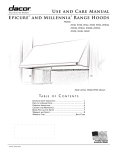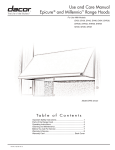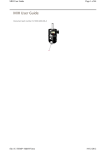Download - Muncie Power Products
Transcript
ADVANTAGE + SD Service Manual - Rev 1 TABLE OF CONTENTS Hydraulics Service Guide.......................................................................................................................... 3 Specifications............................................................................................................................................ 4 Port Designations...................................................................................................................................... 5 Cartridge Designations, Functions and Part Numbers...........................................................................6-7 Schematic.................................................................................................................................................. 8 Explanation of Pressures........................................................................................................................... 9 Solenoid Shift Sequence........................................................................................................................... 9 Explanation of Unloading Circuit............................................................................................................. 10 Explanation of Spreader Circuit............................................................................................................... 11 Explanation of Plow Circuit...................................................................................................................... 12 Explanation of Plow Down Circuit............................................................................................................ 13 Explanation of Hoist Circuit..................................................................................................................... 13 Explanation of Hoist Down Circuit........................................................................................................... 14 Configuring System from Open to Closed Center................................................................................... 15 Installation of Plow Pressure Release Manifold...................................................................................... 16 Electrical Guide Intro............................................................................................................................... 17 Electrical Wiring Assignments................................................................................................................. 17 Electrical Block Diagram.......................................................................................................................... 18 Electrical Joystick Harness...................................................................................................................... 19 Electrical Slave Harness.......................................................................................................................... 20 Electrical Master/Slave Harness.............................................................................................................. 21 Electrical Controller Errors..................................................................................................................22-23 Glossary of Terms.................................................................................................................................... 24 System Troubleshooting.....................................................................................................................25-27 Controller Panel Errors............................................................................................................................ 27 3 HYDRAULIC SPECIFICATIONS HYDRAULIC PRESSURE SETTINGS FUNCTION Main Relief Boost Spreader Plow Up Plow Down Hoist Up Hoist Down DESIGNATION TS3 RV1 RV3 RV5 TS2 RV4 TS1 FUNCTION Inlet Flow Plow Up Plow Down Plow Angle Hoist Up Hoist Down Spinner Auger 4 PSI* 2000 200 1600 1300 600 2300 600 MAX FLOW RATES** 40 GPM 15 GPM 15 GPM 06 GPM 14 GPM 14 GPM 15 GPM 15 GPM RANGE - PSI 1500 - 3600 0 - 500 300 - 3500 300 - 3600 0 - 1700 300 - 3600 0 - 3000 ADJUSTED Electically Mechanically Mechanically Mechanically Electically Mechanically Electically DIFFERENTIAL PSI 200 200 200 200 200 200 200 200 HYDRAULIC PORT DESIGNATIONS T2 HA PLA B P S A PAB PAA PLB HB T DESIGNATION P T T2 A B S PLA PLB FUNCTION Pump Tank Tank 2 Auger Auger reverse/Spreader Return Spinner Plow Up Plow Down SIZE (SAE) 16 16 10 10 10 10 08 08 PGP DESIGNATION HA HB PAA PAB PGP PT1 PT2 PT3 PT1 FUNCTION Hoist Raise Hoist Lower Angle Left Angle Right Pump Gauge Port Pump Pressure Transducer Load Sense Pressure Transducer Plow Raise Pressure Transducer SIZE (SAE) 08 08 08 08 04 04 Modified 04 Modified 04 5 HYDRAULIC CARTRIDGE DESIGNATIONS, FUNCTIONS, AND PART NUMBERS TS3 RV1 FR1 RV3 CV6 RV4 CV7 SP5 RV5 SP6 CV1 EV1 RV6 RV2 SP7 SP3 EP4 SP2 SP4 EP3 EP2 TS1 SP1 EP1 TS2 CV3 CB2 CV11 6 CV10 CV8 CV9 CV2 HYDRAULIC CARTRIDGE DESIGNATIONS, FUNCTIONS, AND PART NUMBERS DESIG PART NUMBER FUNCTION LOC. DESIG PART NUMBER FUNCTION LOC. RV1 NXRV0820A0NC05/02 RV2 NXRV0822A0N26 Boost Pressure Top Plow Angle Left Relief Front SP2 SP3 SP4 SP5 SP6 SP7 ORF1 ORF2 ORF3 ORF4 EP1 EP2 EP3 EP4 FR1 EV1 CL1 CL2 BLK Not Shown NXSP1020AM0N00 NXSP1020M0N00 NXSP08200N00 NXSP0820M0N00 NXSP08200N00 NXSP1057C0N00 NX6101025 NX6101025 NX6101025 NX6101025 NXEP08350N10 NXEP10S350N10 NXEP10S350N10 NXEP10S350N10 NXFR0820F0N/0.20 NXEV12S340N010 COIL 4303612 COIL 4303712 BLOCK 7620110 NX6108080 Auger Spinner CTRL Hoist Raise Hoist Lower Plow Lower Plow Angle Orifice Plugs Orifice Plugs Orifice Plugs Orifice Plugs Plow Compensator Hoist Compensator Auger Compensator Spinner Compensator LS Drain Cartridge Unloader Coil 1 Coil 2 Front Front Right Top Top Front Right Right Front Front Front Front Front Front Left Front RV3 NXRV1022A0N35 Spreader Relief Front RV4 NXRV0822A0N26 Hoist Raise Relief Top RV5 NXRV0822A0N13 Plow Raise Relief Top RV6 NNXRV0822A0N26 Plow Angle Right Relief Front TS1 NXTS1036A0N00 Hoise Lower CTRL Front TS2 NXTS1036C0N0 Plow Lower CTRL Front TS3 NXTS3820AM0N00 Main Relief Top CV1 NXCV08200N10 Plow Lift Check Valve Top CV2 NXCV04200N05 Plow Lower Check Valve Right CV3 NXCV04200N05 Plow Check Valve Right CV6 NXCV08200N25 NXCV04200N05 NXCV10200N15 NXCV10200N15 NXCV04200N05 NXCV04200N05 NXCVD10 NXSP0820M0N00 Body Check Valve Top CV7 CV8 CV9 CV10 CV11 CVD10 SP1 LS Check Valve Top Auger Check valve Back Spinner Check Valve Back Hoist Lower Check Valve Back Hoist Raise Check Valve Back Check Valve Disc Front Right Plow Raise 7 8 HYDRAULIC EXPLANATION OF PRESSURES Pump PSI – The pump pressure Indicates the inlet pressure from the pump. This pressure will always be approximately 200 PSI higher than the load sense pressure. This pressure will never exceed the main relief setting. Load Sense PSI – The Load Sense PSI indicates the pressure communicated from the hydraulic load. With no functions operating, the LS pressure should be 0 PSI. There will only be a LS pressure if a function is operating. Boost / Differential Pressure – The boost or differential (pressure) is the difference between the Pump and the Load Sense Pressures. Typical load sense hydraulic systems require a boost between 200 and 300 PSI. The boost pressure is required to overcome the pressure drop across the valves. Using a gear pump, the boost pressure is set using the boost pressure cartridge. Using a Piston Pump, the boost pressure is adjusted at the pump. SOLENOID SHIFT SEQUENCE Spinner SP3, TS3 Auger SP2, TS3 Plow Raise SP1, TS3 Plow Lower (DA) TS2, SP6, TS3 Plow Lower (SA) SP6, TS3 Plow Left SP7, TS3 Plow Right SP7, TS3 Dump Raise SP4, TS3 TS2, SP5, TS3 Dump Lower (DA) SP5, TS3 Dump Lower (SA) 9 HYDRAULIC EXPLANATION OF UNLOADING CIRCUIT Pump Gage Port (PGP) – Indicates the inlet pressure from the pump. This pressure will be approximately 200 to 300 PSI higher than the Load Sense pressure. Load Sense (LS2) – Indicates the pressure of the load. If more than one function is operating, the higher load pressure will be observed. There will only be a pressure from the LS port if a function is operating. Remember, the Pump Gauge will display a pressure approximately 200 PSI higher than the LS Gauge while a function is operating. EV1 (Plugged when used with a piston pump) – unloading pressure compensating cartridge. EV1 is a normally closed -two position - two way -pilot cartridge. It can provide a low pressure path for pump flow to escape to tank. This is its primary function when the pump is bypassing (no functions operating). The bypass pressure of the pump in this state will vary from about 20-60 PSI depending upon the pump flow. This pressure will show at PGP. The path to tank is opened by pump pressure being applied to the left side pilot of EV1 which forces the valve open. The right side pilot line of EV1 is drained to tank through the TS3 when not engaged (Electrically Actuated Main Relief Valve) to allow the EV1 valve to open fully. TS3 – Electrically Actuated Main Relief Valve. TS3 is a normally open two position - two way solenoid operated relief valve. When its solenoid is not energized it provides a drain path for the pilot pressure on the right side of EV1. This allows for pilot pressure on the left side of EV1 to push it open and expose a low pressure path for the pump flow to escape to tank. TS3 - Will energize whenever any function of the Advantage Plus is operating. This closes the pilot drain on the right side of EV1 and that in-turn causes EV1 to begin shutting off the pump flow escape to tank. Pump flow is now forced to move toward the actuators as required. If TS3 was energized by itself or manually overridden without any other system valves functioning, the pressure at PGP would be approximately 200 PSI to 300 PSI. The L.S. port would not show pressure. In addition, the TS3 valve is used as the main relief. It is an electrically adjustable relief that can be adjusted up to a maximum setting of 3600 PSI. RV1 (Plugged when used with a piston pump) – Boost Pressure Relief Valve. RV1’s purpose is to raise the differential or boost pressure between PGP and LS by a margin of approximately 200 to 300 PSI. It comes into play when TS1 is energized. At that point the pilot pressure on the right side of EV1 can only drain through RV1. RV1’s internal bias spring is set for 200 PSI. That means the pressure of EV1’s pilots (both sides) must build to at least 200 PSI before the right side pilot can drain through RV1 and allow EV1 to begin to open. This boost pressure is required to allow flow to get through other cartridge valves in the system to operate functions. When RV1 has a load-sense pressure applied to its right side, which is communicated from the array of LS check valves (CV2, CV3, CVD10, CV7, CV10, CV11, etc) this will add to the pressure required for EV1 to drain its right side pilot and open. For example, if the load-sense pressure for a spreader motor is 1000 PSI, this will be added to the (200 PSI) spring bias pressure of RV1. Now EV1 cannot begin to open its path to tank until the pump pressure has achieved something slightly higher than 1200 PSI. PGP would display 1200 PSI and L.S. port would display 1000 PSI. In this way the system will always attempt to sustain a differential or boost pressure of approximately 200 PSI. FR1– Load sense drain orifice. FR1 provides a controlled drain for the load-sense pilot line. Its function is to ensure that the pressure cannot be trapped in this pilot and result in EV1 not being able to fully open at low pressure when required. Post Compensators (EP1, EP2, EP3, and EP4) – The post compensators ensure that all functions will operate simultaneously during low pump flow situations (when the circuit requires more oil than the pump can provide). The pilots of the post compensators are directly tied to the LS pressure network. Each compensator will modulate flow by restricting or allowing flow to pass to achieve a constant differential. This differential across all of the compensators allows all of the functions to work with each other to prevent any one function from coming to a complete stop. 10 HYDRAULIC EXPLANATION OF SPREADER CIRCUIT Proportional Valve (SP3) – Spinner flow control valve. SP3 is a proportional solenoid flow control valve. In its un-energized state it provides a blocked path between the pump flow and the spinner work port. When it is energized it provides an increasing orifice opening to flow as a result of increasing electric current to its solenoid coil. Proportional Valve (SP2) – Auger/Conveyor flow control valve. SP2 is a proportional solenoid flow control valve. In its non-energized state it provides a blocked path between the pump flow and the auger/conveyor work port. When it is energized it provides an increasing orifice opening to flow as a result of increasing electric current to its solenoid coil. Relief Valve (RV3) – Spreader Pressure Relief. RV3 limits the pressure of the spreader motor circuits. It is located in the pilot load-sense line of the spreader work ports. It ultimately limits the pressure at the RV1 and therefore EV1 which opens to dump pump flow to tank. RV3 is adjustable. Its pressure setting will be displayed at the LSGP if a spreader motor load exceeds the relief setting or a blockage of a spreader work port occurs. CV8 & CV9 – CV8 and CV9 are back-to-back check valves. Their purpose is to communicate the higher of the two spreader motor pressures of the hoist circuit back to the RV1 boost pressure relief. 11 HYDRAULIC EXPLANATION OF PLOW CIRCUIT SP7 – Plow Angle Directional Control Valve – SP7 has a neutral position and two actuated positions. The actuated positions alternately switch the tank and pressure lines connected to the cylinders to provide opposing angle directions. This valve is known as a motor spool, therefore in its normal position it blocks the pump flow from passing. However, it allows the pressure from the counterbalance valves to drain back to tank. CVD10 – Check Valve – This valve allows the LS signal from the plow angle circuit to be relayed back to the RV1. However, it will prevent the LS signal from back feeding. It only allows oil to travel in one direction. Plow Raise Flow Control (SP1) – SP1 is an electrically actuated proportional two position / two way valve. During its non-energized state, it blocks pump flow from reaching the plow lift cylinder. When energized, it provides an increasing orifice opening to flow as a result of increasing electric current to its solenoid coil. When this valve opens, it allows oil to flow from the pump to the cap side of the cylinder. Plow Lower Flow Control (SP6) – SP6 is an electrically actuated proportional two position / two way valve. During its non-energized state, it blocks the oil from draining from the cap end of the cylinder back to tank. When energized, it provides an increasing orifice opening to flow as a result of increasing electric current to its solenoid coil. 12 HYDRAULIC EXPLANATION OF PLOW DOWN CIRCUIT Plow Down Relief – The TS2 valve is a two position / three way proportional pressure valve. It serves multiple functions. In its non-energized state, it provides a constant 100 PSI of down force on the rod side of the cylinder. When the plow is raising, the oil from the rod side of the cylinder is drained back through this valve. This valve is energized when lowering a DA cylinder. Its purpose is to provide an adjustable pressure to the rod-side of the cylinder. The pressure setting of this valve is adjustable as a function of electrical current. RV5 – Upside Pressure Relief – This is an adjustable relief valve that protects the cap side of the plow cylinder. This is set at the factory at 1300 PSI. The valve will only open if the pressure at the cylinder reaches 2000 PSI. CV1 – Load Holding Check – The purpose of CV1 is to hold the plow in the up position after oil has passed through the SP1 cartridge. It will not allow oil to back feedback through the SP1. CV3 & CV2 – CV3 and CV2 are back-to-back check valves. Their purpose is to communicate load sense pressures of the plow circuit back to the RV1 boost pressure relief. EXPLANATION OF HOIST CIRCUIT SP4 – Hoist Down Relief – SP4 is an electrically actuated proportional two position / two way valve. During its nonenergized state, it blocks pump flow from reaching the hoist cylinder. When energized, it provides an increasing orifice opening to flow as a result of increasing electric current to its solenoid coil. Its function is to raise the hoist. When this valve opens, it allows oil to flow from the pump to the cap side of the cylinder. SP5 – Hoist Lower Flow Control – SP5 is an electrically actuated proportional two position / two way valve. Its function is to lower the hoist. During its non-energized state, it blocks the oil from draining from the cap end of the cylinder back to tank. When energized, it provides an increasing orifice opening to flow as a result of increasing electric current to its solenoid coil. RV4 - Upside Hoist Pressure Relief – This is an adjustable relief valve that protects the cap side of the Hoist cylinder. This is set at the factory at 2600 PSI. The only time it will allow oil to drain back to tank is if the pressure reaches 2500 PSI. 13 HYDRAULIC EXPLANATION OF HOIST DOWN CIRCUIT Hoist Down Relief – The TS1 valve is a two position / three way proportional pressure valve. It serves multiple functions. In its non-energized state, it provides a constant 100 PSI of down force on the rod side of the hoist cylinder. When the hoist is raising, the oil from the rod side of the cylinder is drained back through this valve. This valve is energized when lowering a DA hoist cylinder. Its purpose is to provide an adjustable pressure / down force to the rod-side of the cylinder. The pressure setting of this valve is adjustable as a function of electrical current (Maximum setting = 1000 PSI). CV10 and CV11 – CV10 and CV11 are back-to-back check valves. Their purpose is to communicate the higher of the two hoist pressures back to the RV1 boost pressure relief. CV6– Hoist Shuttle Cartridge – Load Holding Check – The purpose of this valve is to hold the hoist suspended in the air after oil has passed through the SP4. 14 HYDRAULIC CONFIGURING SYSTEM FROM OPEN TO CLOSED CENTER Instructions: 1. Locate the RV1 cavity and remove (Hydraforce P/N: RV08-20A-0-NC-05-02) 2. Replace with NXCP08-20-N 3. Within the control panel configuration menu: a. Locate the Pump Type Selection in the Global Settings Menu b. Toggle the box and change from gear to piston pump RV1 15 HYDRAULIC PLOW PRESSURE RELEASE MANIFOLD INSTALLATION Purpose: This manifold is intended to relieve pressure within the plow angle lines. It allows easier connection between quick disconnect fittings. Operation Instruction: Pull actuators to relieve pressure within the plow angle circuit Installation Instructions: 1. Locate the T Port – Route back to port T2 or the “B” port 2. Locate the PAA Port – Route to the PAA port on the Main Hydraulic Manifold 3. Locate the PAB Port – Route to the PAB port on the Main Hydraulic Manifold 4. Locate the PAA1 Port – Route to the plow left cylinder 5. Locate the PAB1 Port – Route to the plow right cylinder Quick Disconnect Angle RT Quick Disconnect Angle LT PAA - Angle LT PAB - Angle RT Tank 16 ELECTRICAL GUIDE WIRING ASSIGNMENTS Gray Jacketed Cable – This cable supplies the controller with power, ground, and CAN connection. Red Wire – Connect to 12VDC (Battery) with a 20A fused connection. Yellow Wire – Ignition Power: Connect to a fused ignition power source. Black Wire – Connect to Battery Ground Pink Wire – Connect to Speedometer Input Orange Wire (When applicable) – Connect to pre-wet valve or pump (Source Current) Power / CAN - Gray Harness - Route into Cab Black - Connect to Battery Ground Red - Connect to 12VDC Battery Yellow - Connect to 12VDC Ignition Pink - Connect to Speedometer Input Orange - Connect to Pre-Wet 17 ELECTRICAL GUIDE BLOCK DIAGRAM 18 ELECTRICAL GUIDE JOYSTICK HARNESS DB15 PIN ASSIGNMENTS PIN NUMBER WIRE CONNECTION DTM06-6S PIN ASSIGNMENTS WIRE COLOR PIN NUMBER WIRE CONNECTION WIRE COLOR 1 — — 1 DB15 Pin 8 Green (3 Cond) 2 DTM06-6S Pin 2 Red (3 Cond) 2 DB15 Pin 2 Red (3 Cond) 3 — — 3 DT06-4S Pin 3/Resistor Red (2 Cond)/Red (Resistor) 4 DT06-4S Pin 1 Red (4 Cond) 4 DT06-4S/Resistor Black (2 Cond) /Black (Resistor) 5 — — 5 DB15 Pin7 Black (3 Cond) 6 — — 6 — — 7 DTM06-6S Pin 4 Black (3 Cond) 8 DTM06-6S Pin 1 Green (3 Cond) PIN NUMBER WIRE CONNECTION WIRE COLOR 9 DT06-4S Pin 3 Green (4 Cond) 1 DB15 Pin 4 Red (4 Cond) 10 DT06-4S Pin 4 White (4 Cond) 2 DB15 Pin 11 Black (4 Cond) 11 DT06-4S Pin 2 Black (4 Cond) 3 DB15 Pin 9/DTM06-6S Pin 3 Green (4 Cond)/Red (2 Cond) 12 — — 4 DB15 Pin 10/DTM06-6S Pin 2 White (4 Cond)/Black (2 Cond) 13 — — 14 — — CABLE TYPE LENGTH (INCHES) 15 — — 4 Cond 23 2 Cond 9 3 Cond 26 DT06-4S PIN ASSIGNMENTS CABLE LENGTHS 19 ELECTRICAL GUIDE SLAVE HARNESS PIN B.1 B.2 B.3 B.4 B.5 B.6 B.7 B.8 B.9 B.10 B.11 B.12 20 SLAVE 12 POS. PLUG FUNCTION Plow Up Pump Down Plow Down Relief Plow Left Plow Right Hoist Up Hoist Down Hoist Down Relief — — — — WIRE COLOR Tan White Gray Blue Purple Yellow Orange Pink/Green Plug Plug Plug Plug ELECTRICAL GUIDE MASTER / SLAVE HARNESS PIN A.1 To Power Stud Red White Blue Black White Orange Plug Plug Tan Plug Red MASTER 12 POS. PLUG FUNCTION WIRE COLOR Battery Power Red A.3 A.4 A.5 A.6 A.7 A.8 A.9 A.10 A.11 A.12 A.2 Power Can High Can Low Ground Power Can High Can Low — — 5 Volt Input Power Red White Blue Black Red Green White Plug Plug Red Red SLAVE 12 POS. PLUG FUNCTION WIRE COLOR Power Red A.2 Relay Control Can High Can Low Ground Spinner Auger — — Unloader — PIN A.1 A.3 A.4 A.5 A.6 A.7 A.8 A.9 A.10 A.11 A.12 LOAD PRESSURE 4 POS. PLUG PIN FUNCTION WIRE COLOR 1 Ground Black 2 Input Voltage Red 3 — Plug 4 Output Voltage Green PUMP PRESSURE 4 POS. PLUG PIN FUNCTION WIRE COLOR 1 Ground Black 2 Input Voltage Red 3 — Plug 4 Output Voltage Gray MASTER 12 POS. PLUG PIN FUNCTION WIRE COLOR B.1 Hot Oil White B.2 Cold Oil Green B.3 Low Red B.4 Brown Body Sensor 5 Volt Output B.5 Red B.6 Gray Pump Pressure B.7 Load Pressure Green B.8 B.9 Ground Speed B.10 Pink B.11 Temperature Sensor Green Ignition B.12 Yellow DIGITAL INPUT 6 POS. PLUG PIN FUNCTION WIRE COLOR 1 Hot Oil (Digital 1) White 2 Cold Oil (Digital 2) Green 3 Low Oil (Digital 3) Red 4 Body Sensor (Digital 4) Brown 5 Ground Black 6 — Plug 21 ELECTRICAL GUIDE CONTROLLER ERRORS System Errors and messages will appear in the message bar. These messages will include open circuits, short circuits, controller errors, senor warnings, and more. Resolve the issue and depress the “ok” button to clear the message. Consult factor for assistance. Message Bar Operation Messages: Hot Oil – This indicates the hydraulic oil has exceeded 186 degrees Fahrenheit. Allow system to cool and take corrective action to eliminate source of over-heating. Cold Oil – This indicates the hydraulic oil is below 34 degrees Fahrenheit. Cold oil can be very viscous and cause performance issues. Muncie recommends actuating a motor function and allowing the system to warm before performing any rigorous functions. Low Oil – This indicates the oil level is low. Replenish oil level as needed. Filter Bypass – This indicates that the filter bypass switch has been tripped. Change the filter element. Filter Bypass – This indicates that the filter bypass switch has been tripped. Change the filter element. Body Up – This indicates that the body up switch has engaged. Open Circuit Detected – This indicates that a wire or connector has disconnected creating an open circuit condition. Inspect wiring and correct. Short Circuit Detected – This indicates that an output wire is shorted to ground. Please inspect wiring and correct Switched to GPS fallback groundspeed – This message indicates that the groundspeed signal from the truck was lost. Therefore, the GPS signal will be used to calculate the speed of the truck. 22 ELECTRICAL GUIDE CONTROLLER ERRORS Hardware Related Messages: No Master Module Found – Master Module not detected upon startup. Check wiring and correct. Master Lost – Master Module disconnected after startup. Check wiring and correct. Slave Lost – Slave Module disconnected after startup. Check wiring and correct. Motor Mod Lost – Motor Module disconnected after startup. Check wiring and correct. Panel Lost – Cylinder Panel disconnected after startup. Check wiring and correct. Liquid Feedback Sensor Failure –flow turbine not detected. Check wiring and correct. If not utilizing flow turbine, switch to open loop setting in calibration menu. Lost auger feedback – feedback sensor not detected. Check wiring and correct. If not utilizing feedback sensor, switch to open loop setting in calibration menu. Panel Faults: Found Configuration Display Corruption – Configuration file corrupted. Please contact Muncie and check wiring on controller so that it is connected to ignition triggered shutdown. Processor was reset forcibly – This error indicates an unexpected system crash. If problem persists, please contact Muncie. Panel Comm Fault – This message indicates a processor communication error. Try resetting the controller. If problem persists, contact Muncie. 23 GLOSSARY OF TERMS Post Compensation: Post compensation is synonymous with flow sharing. This feature allows all of the hydraulic functions to operate simultaneously during low pump flow scenarios. Remember that without post compensation, oil takes the path of least resistance. Flow sharing modulates downstream pressures in order to keep everything operating. During low flow scenarios, all of the functions may reduce their speeds equally, but all functions should stay operating. Pre-Compensation: This feature does not allow for flow sharing. Simply put, this feature provides stable Flow as pressure fluctuates in a system. However, during low pump flow scenarios, an output may completely stop since the flow will take the path of least resistance. Voltage Compensation: This is a method to control the electrical outputs from the controller. Essentially, the controller maintains a constant voltage at the output on the controller. This is the most cost effective method at controlling a proportional solenoid, however it is not the most precise method. As the solenoid coil heats, it’s resistance increases which changes the performance of the valve. Current Compensation: This is another method to control the electrical output from a controller. Although this is a more expensive method, it is the most precise method. As the coil heats and the resistance changes, the controller allows the output to increase the voltage to compensate and keep the output current consistent. Load Sense: Load sensing was developed to improve the efficiency of a circuit. All of our manifolds incorporate LS sensing technology. Load sensing allows the system to build the pressure that the circuit requires, allowing us to draw less horsepower. Open Center: Open center refers to valve types. Open center valves are used with fixed displacement pumps (gear) and allow the flow to dump back to tank during system bypass. Without a designated passage to tank, the flow would constantly bleed over relief. Closed Center: Closed center refers to valve types. Closed center valves are used with variable displacement pumps (piston). These valves do not offer a passage to tank. Instead, the variable displacement pump de-strokes preventing it from generating flow. Keep in mind that the piston pump destrokes when the LS signal is at 0 PSI. Closed Loop: Closed loop is typically referencing the functionality of the conveyor or pre-wet function. Years before the use of cartridge valves and current control, closed loop control was required to achieve consistent hydraulic performance. Specifically, stack valves have excessive hysteresis and overshoot. By placing a feedback sensor on the auger shaft, we can measure how many revolutions per minute the shaft spins. Knowing the RPM, we can then modulate our current to achieve our desired output. Simply put, if we dial in 200 Lbs. / mile and the valve opens up too much, the feedback sensor will recognize the inconsistency and readjust the signal to the valve to limit the flow to accomplish the desired setpoint. Open Loop: Open loop typically refers to the conveyor or pre-wet function. Open loop simply means that electrical feedback isn’t required. Today with the use of cartridge valves and current control, feedback sensors really aren’t required however they can provide more precision. The advantage plus has the capability to do either open or closed loop. Open Circuit Detection: The Advantage Plus Controller has built in diagnostics that detect when a solenoid is unplugged. When this occurs, the controller will generate an error code on the screen and a button (cylinder function) or display (spreader function) will flash. Many of our competitors have test lights at the valve to indicate that the electrical connection is connected and firing. However, our buttons provide real time feedback by turning from green to red to indicate that an output is connected and actuated. Digital Input – Digital inputs are simply on or off switches that are connected to the system. Digital inputs include oil level float switches, body up switches, hot oil switches, cold oil temperature switches, and filter bypass switches. Analog Input – These are inputs that generate a proportional 0-5 volt signal. In the Advantage Plus, analog inputs include the pressure transducers that measure the hydraulic pressures. PWM input – These inputs provide a pulsed signal (either square or sine). Examples of PWM signals include speedometer sensors, IR temperature sensors, and feedback sensors. CAN inputs – These are inputs that are connected to out CAN-BUS network. Typically, these will have a power, ground, CAN-Hi, and CAN-Lo connections. Examples of these connections include: IR temperature sensors. 24 ADVANTAGE PLUS SYSTEM TROUBLESHOOTING HF96083-14 ISSUE POTENTIAL PROBLEMS System Powered, but nothing operated hydraulically Verify that the PTO is engaged / Is Pump Producing Flow Contamination in Unloader Compensator (EV1) Contamination In Boost Relief (RV1) Contamination in Main Relief (TS3) Boost Pressure Relief is set too low (RV1) If using piston pump, check stand-by settings on pump If using piston pump, make sure LS line is routed back to appropriate port Check to see if modules are recognized - If not, check CAN connection Verify that Modules are Plugged into harness Verify that Controller has been programmed with system profile Electronics do not power Check to see if ignition input is connected to 12VDC Check Power and Ground Connections Check Fuse Check to make sure the master module is plugged in If applicable, check the ignition source fuse on the truck Check the relay and connections located within the enclosure PLOW LIFT ISSUES ISSUE Plow Does Not Raise POTENTIAL PROBLEMS Check the Controllers Speed Settings Check the Plow Down Manual Override (SP6) Check the Plow Down Flow Control for Contamination (SP6) Check the Plumbing (are the PLA and PLB ports plumbed backwards) Check the Plow Down Relief for Contamination (RV5) Check if the Plow Cylinder is leaking internally Check CV3 for Contamination blocking LS signal Check Cylinder Panel Harness - Buttons should change from green to red when pushed Sync Truck Profile Plow Raises Slowly and Drifts Back Down Check for Contamination in the plow down flow control (SP6) Check for Contamination in the Plow Up Relief (RV5) Check Load Holding Valve for Contamination (CV1) Check if the plow cylinder is leaking internally Plow Slams Down Decrease the maximum plow speed settings 25 TROUBLESHOOTING PLOW ANGLE ISSUES ISSUE Plow Does Not Angle (left or right) POTENTIAL PROBLEMS Check the plow angle speeds in the controller Check the electrical circuit for opens and shorts (Look for error messages) Check crossover relief “on Plow” Check to see if quick disconnects are seated properly Check to see if quick disconnect manifold is held open (debris) Check EHPR1 (Plow Right Pilot) or EHPR2 (Plow Left Pilot) Check PE2 fo Contamination Check CV4 or CV5 for contamination Do the cylinder panel buttons change from green to red - If not, check the harness Sync Truck Profile Plow Angles Slow Check the Controller Speed Settings Make sure plumbing is not restricting flow Is Pump Undersized (need more displacement) Check Boost Pressure Setting Sync Truck Profile HOIST ISSUES ISSUE Hoist Does Not Raise POTENTIAL PROBLEMS Check the Controller Speed Settings Check the Hoist Down Manual Override (SP5 or Additional SP) Check the Hoist Down Flow Control for Contamination (SP5 or additonal SP) Check the Plumbing (are the HA and HB ports plumbed backwards) Check the Hoist up Relief for Contamination (RV4) Check if the Plow Cylinder is leaking internally Hoist Raises, but drifts down slowly Check the flow control for contamination (SP5 or Additional SP) Check the hoist upside relief (RV4) for contamination Check the load holding check valve for contamination (CV6) Hoist Raises Slowly Check the Controllers Speed Settings Check the pump displacement - May need larger displacement pump Check Boost Pressure Relief Setting - Should be set at 200 PSI SA Telescopic Hoist Lowers Slowly Did we check the controller speed settings Verify that hoist isolation plug is installed? Is T2 routed directly to the Reservoir Did we install a second SP16 in the CP2 cavity to lower the hoist Hoist Slams Down When Lowering 26 Turn the Hoist Max Speeds Down on the controller TROUBLESHOOTING SPREADER ISSUES ISSUE Spinner Does Not Operate POTENTIAL PROBLEMS Check the Controllers Speed Settings Check the Plumbing - Are we deadheading the function Check the quick disconnects If the function operates when switch motors, could have faulty motor Check the Spreader Relief Valve for contamination Check CV9 - is LS signal being relayed back to boost pressure valve Check CV7 - is the LS signal being relayed back to boost pressure valve Auger / Conveyor Does Not Operate Check the controllers speed settings Check the Plumbing - Are we deadheading the function Check the quick Disconnects Swapping supply to spinner, could have faulty motor Check the Spreader Relief Valve for contamination Check CV8 - is LS signal being relayed back to boost pressure valve Check CV7 - is LS signal being relayed back to boost pressure valve SYSTEM IS OVERHEATING ISSUE System is Getting Hot POTENTIAL PROBLEMS 1. Check the standby pressure - Contamination in LS Drain 2. Check pressure with motors engaged - Bad Quick Disconnect 3. Verify that we do not have excess pump flow 4. Verify that the low oil / cold oil sensor isn’t plugged into the wrong input CONTROLLER ERROR MESSAGES ISSUE Air/Road Temp Sensor Not Functioning 1. Verify that a sensor is installed and wired correctly 2. make sure that the system is configured for this sensor (must be factory configured) 3. Check the Power and Ground Connections of the sensor 4. Verify that all of the pins are in the correct locations and seated correctly in their housing 5. Verify that the lens cover was removed after installation Air / Road Temp Sensors are Incorrect 1. Try Calibrating the Sensor to the Controller 2. Verify the Air / Road Temp Sensor is mounted in an appropriate location and not reading temperatures from the exhaust. 3. Contact Muncie for Lens replacement PSI Not Displayed on Controller 1. Verify that the appropriate connector is plugged into the transducer receptacle 2. Verify that the pin of the connector are seated properly. Incorrect PSI Shown on Controller 1. Replace the Pressure Transducer 27 Muncie Power Products, Inc. Member of the Interpump Hydraulics Group General Offices and Distributon Center • P.O. Box 548 • Muncie, IN 47308-0548 (765) 284-7721 • FAX (765) 284-6991 • E-mail [email protected] Web site http://www.munciepower.com SP15-04 © Muncie Power Products, Inc. 2015 Drive Products, Exclusive Agents for Canada, ISO Certified by an Accredited Registrar




























